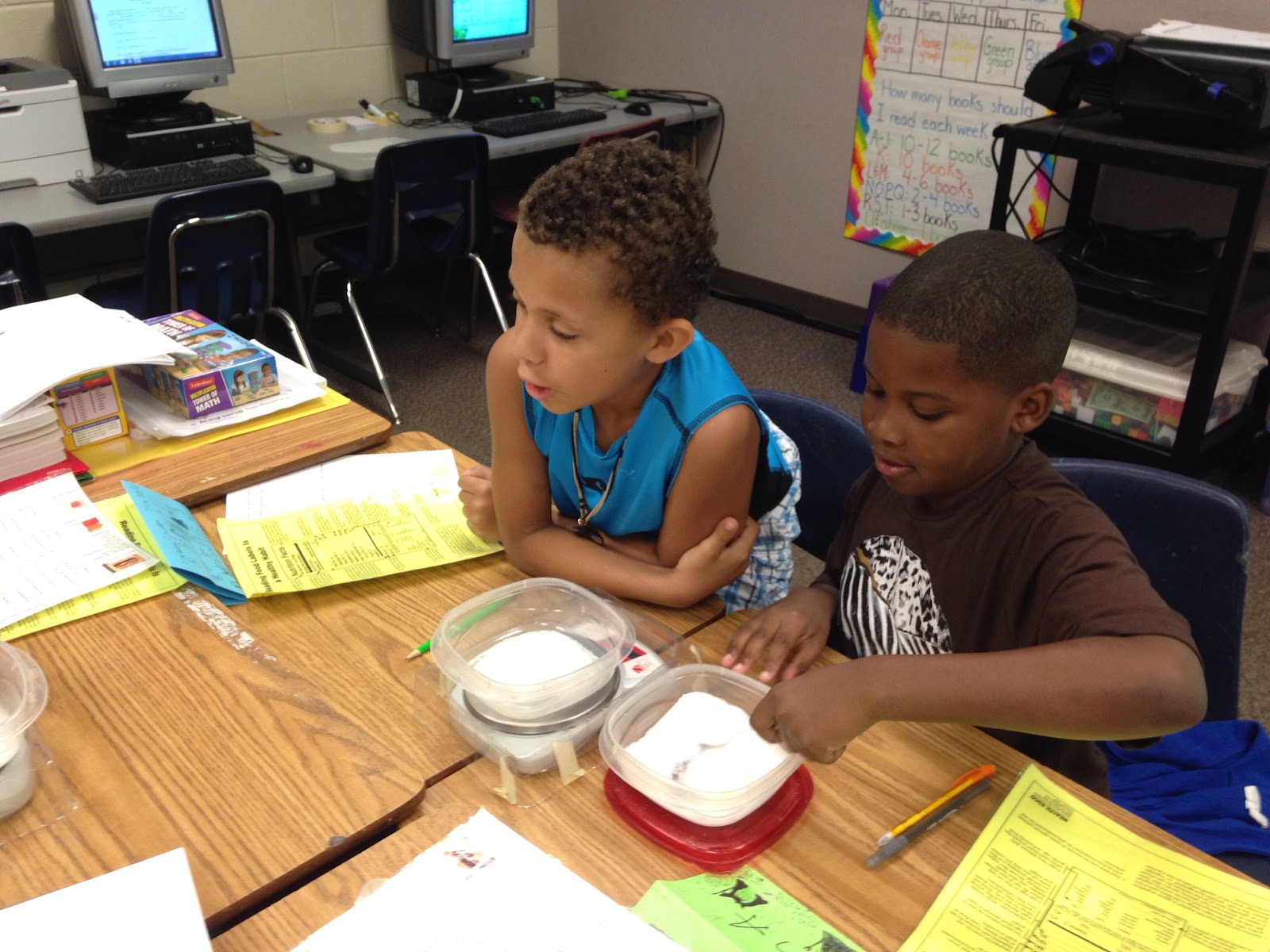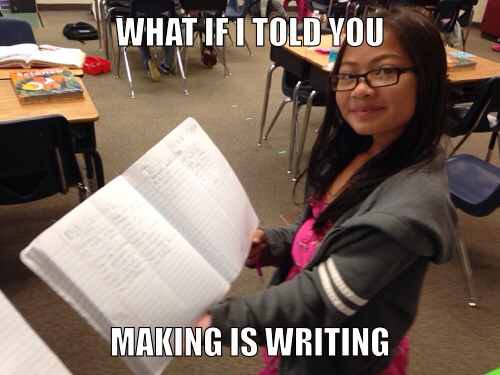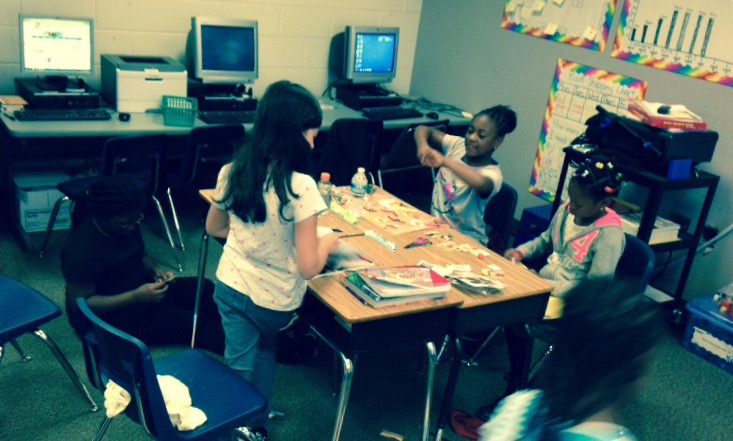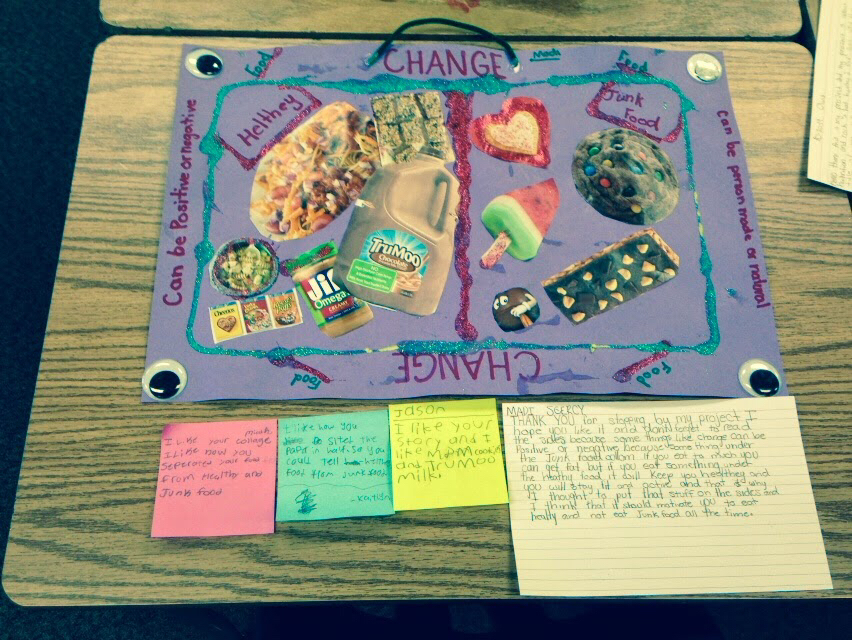My first “real” attempt to bring the concept of “make” into my 4th grade classroom came as a result of my involvement in the Intersections Project. In collaboration with my Discovery Place thinking partners I devised a culminating project my students would engage in as they finished a Science unit on Nutrition. Prior to my involvement in this project I questioned whether or not the informal, authentic process of “thinking like science expert” that my Discovery Place partners brought to our collaboration would mesh with the more formalized manner that science is taught in schools. It is easy to understand why pressure coming from things like curriculum guides could complicate the manner in which “makes” find their way into public school classrooms. The language of a curriculum guide includes standards, objectives, and descriptions of activities; literally spelling out what is supposed to be done relevant to the content it was created for. Over time, this language can place a sort of linguistic net over the rich experiences of students during MAKE cycles. This net (a systemic construct that is neither malicious nor benevolent) through language, ends up determining what is a learning experience, how students grow, and finally what learning looks like at any given moment in our classrooms so as to report out to the world the kind of learning that is taking place. This resource seeks to construct something different, an image of possibility for educators, leaning on what might, at first glance, seem familiar (how a teacher could navigate her way through an upper elementary Nutrition unit), when it comes to considering the ways in which “make” finds its way into our classrooms. As we move forward, cultivating our own images of what is possible, reflecting about them with our students and each other, we can begin to speak back, maybe even re-define the systemic construct mentioned above.
The Nutrition Make
Prior to the project the students participated in several experiences, some traditional, some quite unique given the formal setting of the classroom. The traditional experiences included reading information related to nutrition in their Science textbooks and taking notes about the readings. One unique experience involved getting the students to learn about how much fat and sugar is in a typical fast food meal; thanks to a really exciting, interactive lesson my Discovery Place thinking partners led with the class. The informal (social) nature of this experience; hypothesizing, measuring, recording, thinking, discussing, and reporting out seemed very far away from the more formal (isolated) approaches where students would read and answer questions about that reading. To say this experience was met with high levels of joy and enthusiasm from my students is a mere understatement!

We had the students reflect, in their notebooks, about what they were learning and how change (defined in this case as the choices one makes regarding his/her dietary choices) can be positive or negative.

Choosing to layer the theme of change over the standards and objectives for the Nutrition unit was a decision we made prior to the beginning of the school year while planning with together. We were looking for a way to bring some critical thinking and complexity into an otherwise standard science unit. We wanted the students to be able to "bridge" what they were learning in science and literacy in a somewhat sophisticated fashion. Interdisciplinary thematic instruction includes taking large scale themes, like change, and generalizations like "Change can be positive or negative;" layering both over the curriculum so that students can use the content, (the Nutrition unit in this case) to prove or disprove the generalization while learning something new about the theme. As the Nutrition unit came to a close we wanted the students to engage in a “make” that would enable them to “mine” the experiences, reflections, and ideas related to change they had engaged in. Why might you ask was this “make” integral to the overall experience?
Why it Matters!
One of the tenants of “make” is that it, “invites students to make things with words, with natural and manmade materials, and with their ideas of how to make their worlds.” We proposed the following to the students; create a collage, using images and text from magazines, art supplies (pipe-cleaners, glitter, ribbon, stickers, construction paper, markers, colored pencils, etc.) to “make” a representation of concepts learned throughout the unit. The collage also had to show evidence of the generalization “Change can be positive or negative.” By participating in this “make” students were in essence re-presenting their understanding of a concept (nutrition) that had been presented to them throughout the unit; they were “making” new and unique images of what nutrition meant to them. Being asked to re-present your understanding is different than being asked to re-produce what has been presented to you. Re-presenting implies you are capable of being creative both textually (with language) and concretely (with materials) you have at your disposal. Re-presenting implies that from this creativity, you have something important to say. Re-presenting implies that what you have to say should be shared, with others as you engage in “making your world.”

Another important tenant regarding the concept of “make” played itself out during this culminating project. Make, “use[s] content specific to a grade levels' course of study and [is] literacy rich, asking students and teachers to share, reflect, loop back, remake, revise, remix, and connect with others.” The content specific to my students’ grade level was nutrition. The content was literacy rich in that I pulled material from the students’ textbooks, trade-books, as well as online materials. Throughout the project we shared ideas with each other as the students planned what to include in their collages. Typically there is not space for sharing, reflecting, looping back, remaking, revising, remixing and connecting within the confines of formal learning. Skype chats, Google Hangouts, real-time, in person meetings with both my thinking partners from Discovery Place and my National Writing Project colleagues helped me facilitate this informal, authentic, and crucial component to the culminating project.
Typically, due to the linguistic, systemic net that is cast over teaching and learning, teachers are supposed to present content, students are supposed to receive it, then reproduce it in the form of some kind of standardized, formative assessment meant to measure what was received. Working against from within this “net,” the students looped back to the literature/content (they received) as well as the notes they had taken, not to reproduce what they received, but to put their collages together in an attempt to ensure that what they were “making” was a re-presentation of what they had learned.
Here is an example of student’s MAKE...a re-presentation of what was learned...

This student’s collage focuses on what she learned during the Nutrition unit. She has arranged what she has learned about food into 2 categories, foods that are healthy and “junk food.” What sets this MAKE apart from others is an integration of the theme and generalizations explored over the course of the unit. This is evidenced strategically around the outside of her collage. Most notably, the student placed the theme at the top and bottom of the collage. The generalizations; “Change can be positive or negative” and “Change can be person-made or natural can be found on the left and right of the collage. A closer look at her writing (see the index cards) reveals that these thoughts about change are not just placed there “for show.” She encourages her viewer to think about her placement of the words and phrases and why thinking about food this way “should motivate you to eat healthy” and “not eat junk food all the time.” Her classmates acknowledge the intent of her work (as evidenced through the 3 sticky notes) showing that her message resonates with them. The results of my student’s efforts may not necessarily be measured via standardized testing...but (as witnessed in the example) are equally important in order for children to re-imagine what is possible from their position as student learners engaged in JOYFUL learning experiences!
 For this make, students drew upon the setting and novels they were reading in language arts and their learning about sustainability in science class to construct cardboard cities. For language arts, students participating in books clubs, where students read in small groups a novel with a group of their classmates and regularly completed literacy-related mini-lessons and group discussions. The novels, 20 or so in all, spanned in genre from biography to dystopian fiction, but fit thematically into the unit being taught, which focused on responding to injustice.
For this make, students drew upon the setting and novels they were reading in language arts and their learning about sustainability in science class to construct cardboard cities. For language arts, students participating in books clubs, where students read in small groups a novel with a group of their classmates and regularly completed literacy-related mini-lessons and group discussions. The novels, 20 or so in all, spanned in genre from biography to dystopian fiction, but fit thematically into the unit being taught, which focused on responding to injustice.